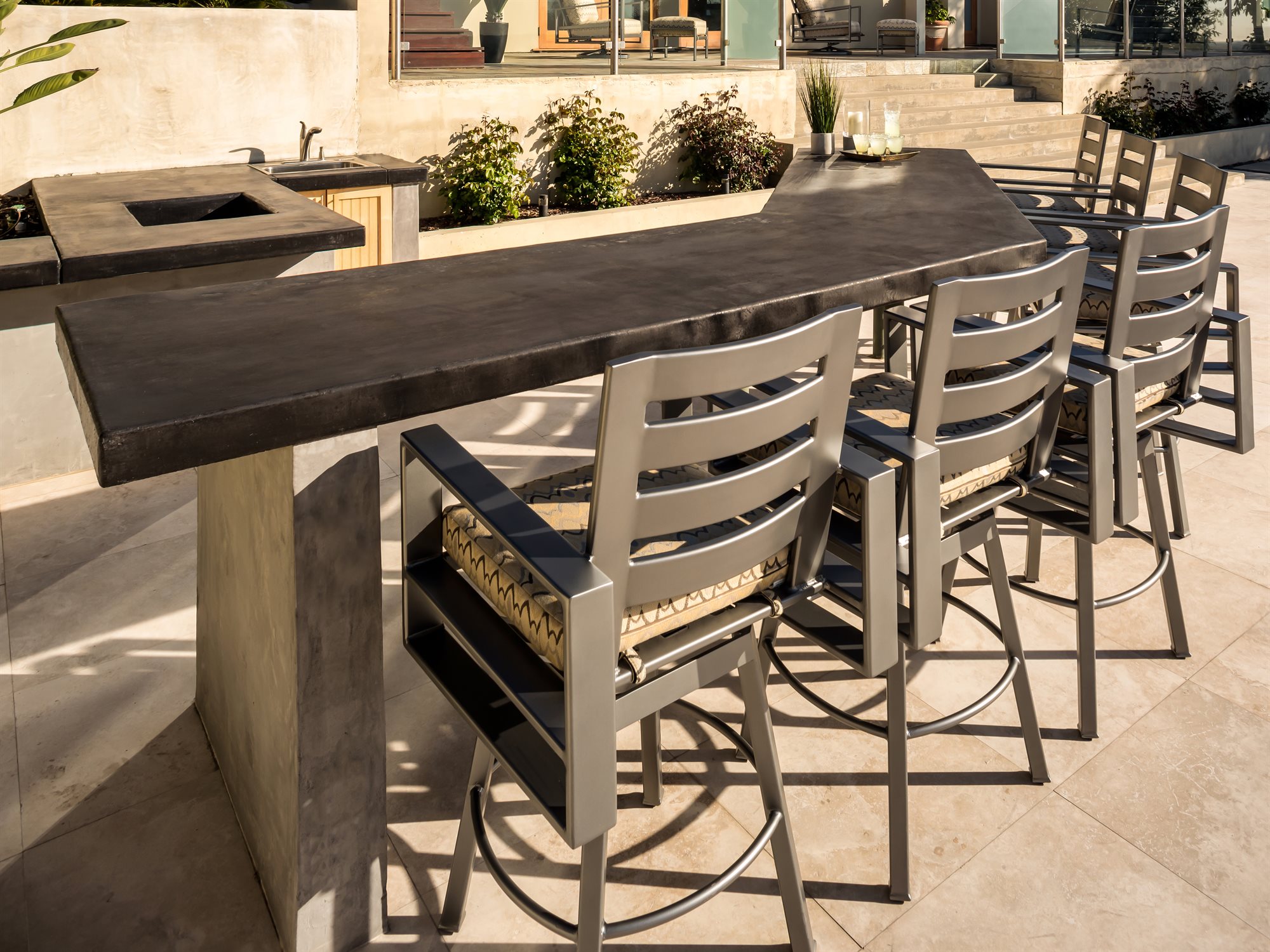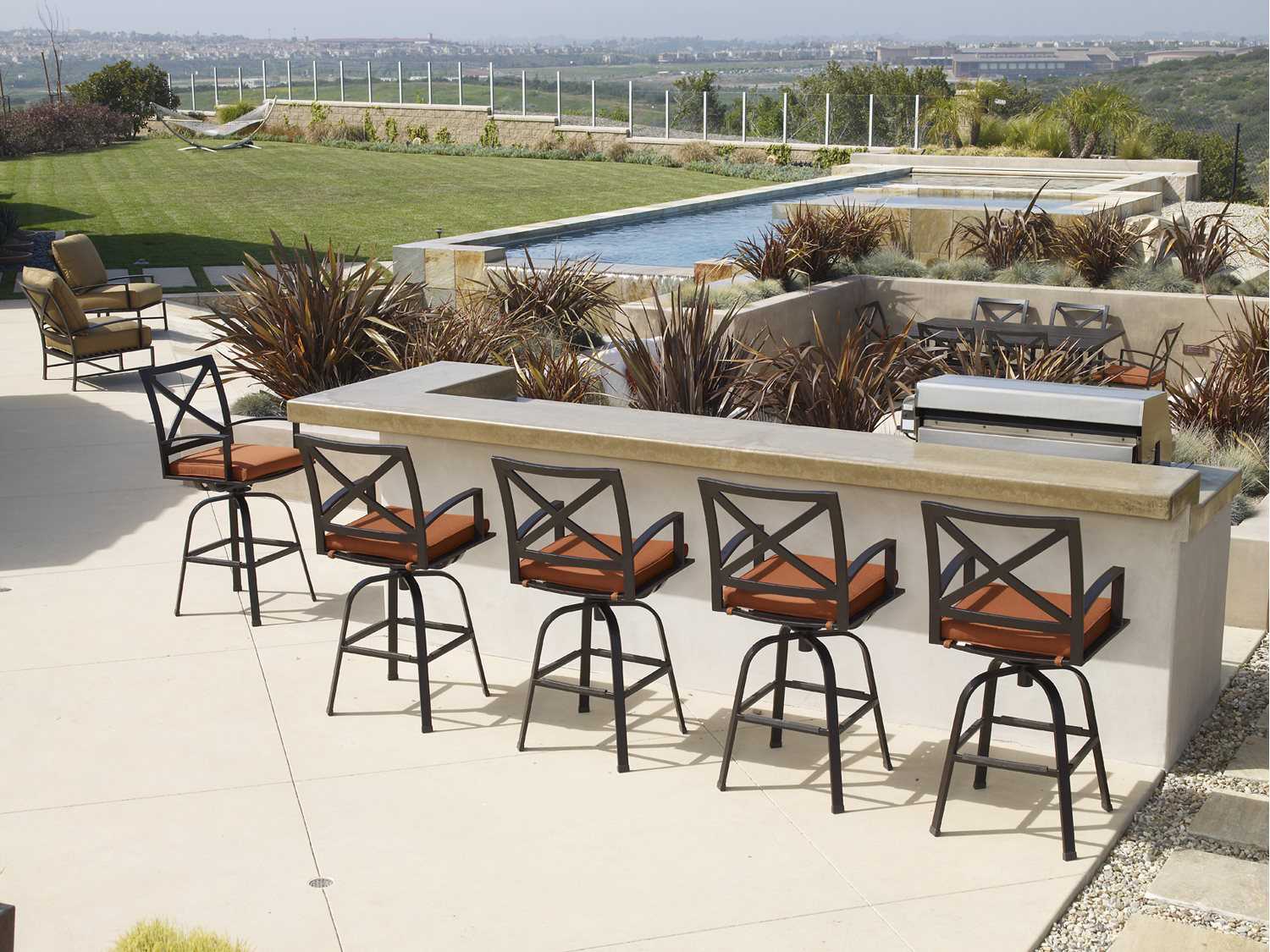


Whether you’ve sat at a bar enjoying an after dinner drink, or been seated at a high top table for Sunday brunch, you’ve probably found yourself sitting on a bar stool at least once in your life. Bars, restaurants, and hotels, particularly those with outdoor patios, often utilize bar tables and bar seating to accommodate guests. Bar tables and bar stools are taller and generally take up less space than traditional dining sets, so they are the ideal option to ensure ample seating. Although they can sometimes have the look and feel of a commercial space, you can find stylish and functional bar stools perfect for your very own home patio.
If you like to entertain in your backyard, you need to make sure you provide enough tables and chairs for all of your guests. Beyond a traditional dining set or lounge set, bar tables and bar stools are a great option for your patio, especially if you’re working with minimal space. Bar height furniture is taller than regular furniture and a great casual addition to your patio. Bar stools in particular are important because you want to make sure your guests have access to comfortable seating at your bar table or bar counter.
Choosing the right bar stools for your space can be tricky. First you need to figure out the stool height needed so that guests are seated comfortably at your bar or bar table. Then you need to figure out the amount of bar stools you need. If you’re choosing seating for a table, you need to consider the size of the tabletop, and at a bar or counter you need to make sure you have enough seating without overcrowding the space. Then, you can choose the style and materials to best fit your needs and personal design preferences. In this guide, we will walk you through the different options available and how to select the perfect bar stools for your space.
Sometimes you may see “counter height stools” and “bar stools” used interchangeably, but it is important to note that these two types of stools are actually quite different. Counter height stools are a bit shorter than bar stools, and intended for use at a kitchen counter or counter height table. Bar stools are slightly taller and meant to be used at a bar or bar table. The height of your bar stool can be best determined by first measuring the height of your bar or bar table. You want to make sure that the user can comfortably rest his or her arms on the table surface, while still leaving enough room for their legs under the table’s edge. Tip: Measure the space between the floor and your bar or tabletop at least twice to ensure accuracy before purchasing bar stools.
The seat height, or distance between the floor and seat, of a bar stool is typically 30 to 36 inches. These bar stools fit best at a standard bar or bar table that measures 40 to 46 inches tall. When determining the number of bar stools you need, be sure to leave 26 to 30 inches between the center of one stool and the center of the stool next to it, so your guests can sit comfortably and get in and out of their seat easily. If your bar is situated next a wall, be sure to leave 14 inches between the wall and the center of the stool closest to the wall. Tip: Leave extra room for swivel bar stools so that they are not bumping into each other when someone swivels the seat in or out.

Once you determine the height and amount of bar stools you need for your space, you can choose between a wide variety of styles to best suit your needs.
Backless bar stools typically have a round or rectangular seat, and can be sometimes be cushioned. Backless bar stools are great if you have limited space and need to push the entire stool under the table or counter when they are not in use. The are also typically more lightweight and ideal for storage. Bar stools with backs offer more support to the user and are thus more comfortable. However, they do take up additional space and are not usually storage-friendly unless you opt for stackable stools.
Much like bar stools with backs, stools with arms also offer more support and are more comfortable, however they also take up more space. If you choose to purchase bar stools with arms, make sure you have properly measured your bar or table height and the arms of your stools can be easily pushed under the surface when not in use.
Because bar stools can sometimes be heavy, you may want to consider a stool that swivels. This way, you and your guests won’t have to drag the heavy stool away from the counter and scoot back in once you’re seated. You can just swivel the seat toward you and hop right in. However, swivel stools take up more space than stationary stools, especially if they also have arms, so it’s important to consider the amount of space you have available.
Bar stools of all styles come in a variety of materials, which can vary by both the frame material and seating material. The frame of your bar stool can be made of aluminum, cast aluminum, wicker, wrought iron, steel, teak, wood, recycled plastic, and resin. The material that will work best for your space depends on the climate in your area, and your desired look. Certain materials hold up better in wet conditions than others, and some are more lightweight and ideal for storage in the off season.
Bar stool seating materials include sling, cushion, strap, metal, wicker, teak, wood, recycled plastic, and resin. The seating you choose depends largely on comfort and your desired look. Upholstered and cushioned seating is the most comfortable and will give your space a high-end look, but if you are looking for something more durable, you may opt for sling. This is entirely up to your personal preference.
Each material comes in a vareity of colors and finishes to blend seamlessly into your decor and give you your desired aesthetic. For more information about the benefits of the different outdoor materials, check out our Outdoor Materials Buying Guide.



